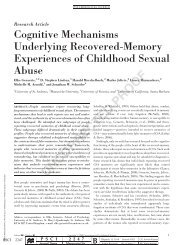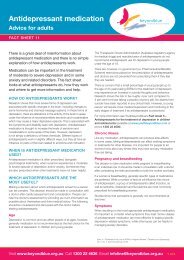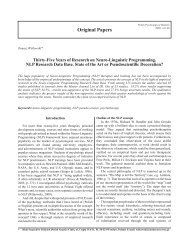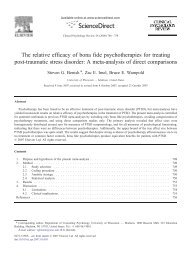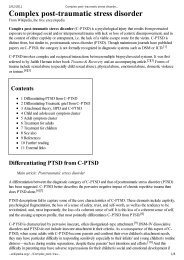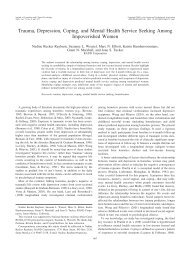The Sociocognitive Model of Dissociative Identity Disorder: A ...
The Sociocognitive Model of Dissociative Identity Disorder: A ...
The Sociocognitive Model of Dissociative Identity Disorder: A ...
You also want an ePaper? Increase the reach of your titles
YUMPU automatically turns print PDFs into web optimized ePapers that Google loves.
52 CLEAVES<br />
and the credibility <strong>of</strong> each was ensured by a panel <strong>of</strong> experts in<br />
each field. Overall, an accurate diagnosis <strong>of</strong> DID was made by<br />
only 22% <strong>of</strong> the clinicians (compared with 54% for<br />
schizophrenia). <strong>The</strong>re was only one false-positive diagnosis <strong>of</strong><br />
DID (a clinician who rated the patient in the schizophrenia vignette<br />
as having DID). Thus, false-negative diagnoses <strong>of</strong> DID<br />
far outweighed the false positives. Perhaps most critically, skepticism<br />
about DID predicted diagnostic inaccuracy.<br />
It is certainly possible that some <strong>of</strong> the recently reported cases<br />
<strong>of</strong> DID have been false-positive diagnoses, made by untrained<br />
or overzealous practitioners. However, such diagnostic errors<br />
are also likely to occur with any psychiatric disorder. Given the<br />
findings by Hayes and Mitchell (1994), as well as that dissociative<br />
patients are frightened to disclose their symptoms, such<br />
symptoms are not included in standard mental status examinations,<br />
and most practitioners may not screen for or even know<br />
how to screen for dissociative disorders, it seems unwarranted<br />
to conclude that the false-positive diagnoses <strong>of</strong> DID outweigh<br />
the false negatives.<br />
Has the <strong>Disorder</strong> Changed Over Time?<br />
In support <strong>of</strong> the sociocognitive model <strong>of</strong> DID, some <strong>of</strong> its<br />
proponents (Merskey, 1992; Spanos, 1994) suggest that there<br />
have been marked changes in the symptomatology <strong>of</strong> DID over<br />
time. <strong>The</strong> features that have allegedly changed are the number<br />
<strong>of</strong> alters and the association with childhood trauma. According<br />
to Merskey and Spanos, the number <strong>of</strong> alters has allegedly increased<br />
and the association with childhood trauma has only recently<br />
developed.<br />
<strong>The</strong> average number <strong>of</strong> alters described in written reports<br />
may have increased (North et al. 1993). However, early reports<br />
were based on the number <strong>of</strong> alters that were spontaneously reported<br />
by the patient, whereas later reports been based on active<br />
assessment on the part <strong>of</strong> the clinician or researcher; thus, the<br />
numbers are not directly comparable. <strong>The</strong> average number <strong>of</strong><br />
alters reported at the time <strong>of</strong> diagnosis has apparently remained<br />
consistent over time (Ross, Norton, & Wozney, 1989). Although<br />
one could argue that the assessment process is creating<br />
new alters, more recent data on the character <strong>of</strong> DID patients<br />
suggest an alternative interpretation may be more parsimonious.<br />
Given that patients with DID frequently appear to be<br />
avoidant and distrustful (Ellason et al., in press; Kluft, 1991a)<br />
and report being extremely afraid and ashamed <strong>of</strong> their dissociative<br />
symptoms (Cohen et al., 1991), it seems highly unlikely<br />
that such individuals would be likely to spontaneously volunteer<br />
all aspects <strong>of</strong> their dissociative symptomatology.<br />
For the same reason, it would be unwarranted to assume that<br />
patients with DID would be likely to spontaneously report having<br />
been sexually abused. One would have to make this assumption<br />
to conclude that the association between DID and abuse<br />
has recently developed because the data for such a conclusion<br />
are a few early case reports in which patients did not spontaneously<br />
report histories <strong>of</strong> abuse (see Spanos, 1994). Recent data<br />
suggest that individuals with documented abuse histories are<br />
<strong>of</strong>ten unlikely to report such histories for several possible reasons<br />
(Femina, Yeager, & Lewis, 1990; Williams, 1994). <strong>The</strong><br />
cases to which Spanos referred (from the early part <strong>of</strong> the 20th<br />
century) were also reported during a time period when incest<br />
was believed to be almost nonexistent, routine inquiries were<br />
not made, and reports were <strong>of</strong>ten not believed or were interpreted<br />
as fantasy (Bowman, 1990; Olafson, Corwin, & Summit,<br />
1993), making it even less likely that abuse would be reported<br />
or recognized.<br />
A more parsimonious interpretation <strong>of</strong> the data regarding<br />
DID and childhood trauma is that the recognition <strong>of</strong> the association<br />
is relatively new. Similar conclusions were reached by Carson<br />
and Butcher (1992) who noted that "while it is somewhat<br />
amazing that this connection [between DID and childhood<br />
trauma] was not generally recognized until about 1984, there is<br />
now no reasonable doubt about the reality <strong>of</strong> this association"<br />
(p. 208). <strong>The</strong> data that support such conclusions regarding the<br />
association between DID and childhood trauma are discussed<br />
in detail below (see Child Abuse and DID).<br />
In summary, there remains a lack <strong>of</strong> data that strongly suggest<br />
that iatrogenic factors have been at work in the creation <strong>of</strong> alteration<br />
<strong>of</strong> DID. More research is needed on the prevalence <strong>of</strong><br />
DID and other dissociative disorders before their true prevalence<br />
can be determined. However, researchers who have systematically<br />
evaluated the conditions have found them to be relatively<br />
common among general clinical and nonclinical samples.<br />
In the reports <strong>of</strong> low prevalence, researchers did not screen<br />
for or assess dissociative symptoms. Thus, the wide range in<br />
prevalence estimates can be parsimoniously explained by<br />
whether the disorder was assessed. <strong>The</strong> same can be said for<br />
cross-cultural studies. A number <strong>of</strong> factors quite parsimoniously<br />
explain the recent increases in the reporting <strong>of</strong> DID, none<br />
<strong>of</strong> which are based on the hypothesis that the disorder is being<br />
created iatrogenically or overdiagnosed any more than any<br />
other psychiatric disorder. No conclusive data suggest that the<br />
disorder has changed over time, either.<br />
Child Abuse and DID<br />
Researchers <strong>of</strong> recent studies have consistently found a strong<br />
association between DID and forms <strong>of</strong> childhood trauma. Patients<br />
have been found to almost invariably report some form<br />
<strong>of</strong> childhood trauma, most commonly physical abuse, sexual<br />
abuse, or both (see Table 3). <strong>The</strong> abuse reported by individuals<br />
with DID is <strong>of</strong>ten severe, extensive, and sadistic (Kluft, 1985;<br />
Putnam, 1989; Wilbur, 1984).See Kluft( 1985,1994) for illustrative<br />
case examples. Other forms <strong>of</strong> childhood trauma have<br />
also been reported including neglect, abandonment, wartime<br />
experiences, seeing one's parents or sibling killed, near death<br />
experiences (e.g., near drowning), and painful medical procedures<br />
(Coons et al., 1988; Kluft, 1984; Putnam, 1989; Ross,<br />
Norton, & Wozney, 1989).<br />
In two <strong>of</strong> these studies, the investigators also systematically<br />
evaluated whether the patients with DID met the criteria for<br />
PTSD. Boon and Draijer (1993a) reported that 81% <strong>of</strong> the patients<br />
in their sample met the PTSD criteria, and Ellason et al.<br />
(in press) diagnosed PTSD in 79% <strong>of</strong> the patients in their sample.<br />
J. W. Ellason (personal communication, October 7, 1994)<br />
reported that, <strong>of</strong> the patients who did not meet the full PTSD<br />
criteria, all endorsed some <strong>of</strong> the criteria.<br />
Several recent studies have also demonstrated a general rela-



